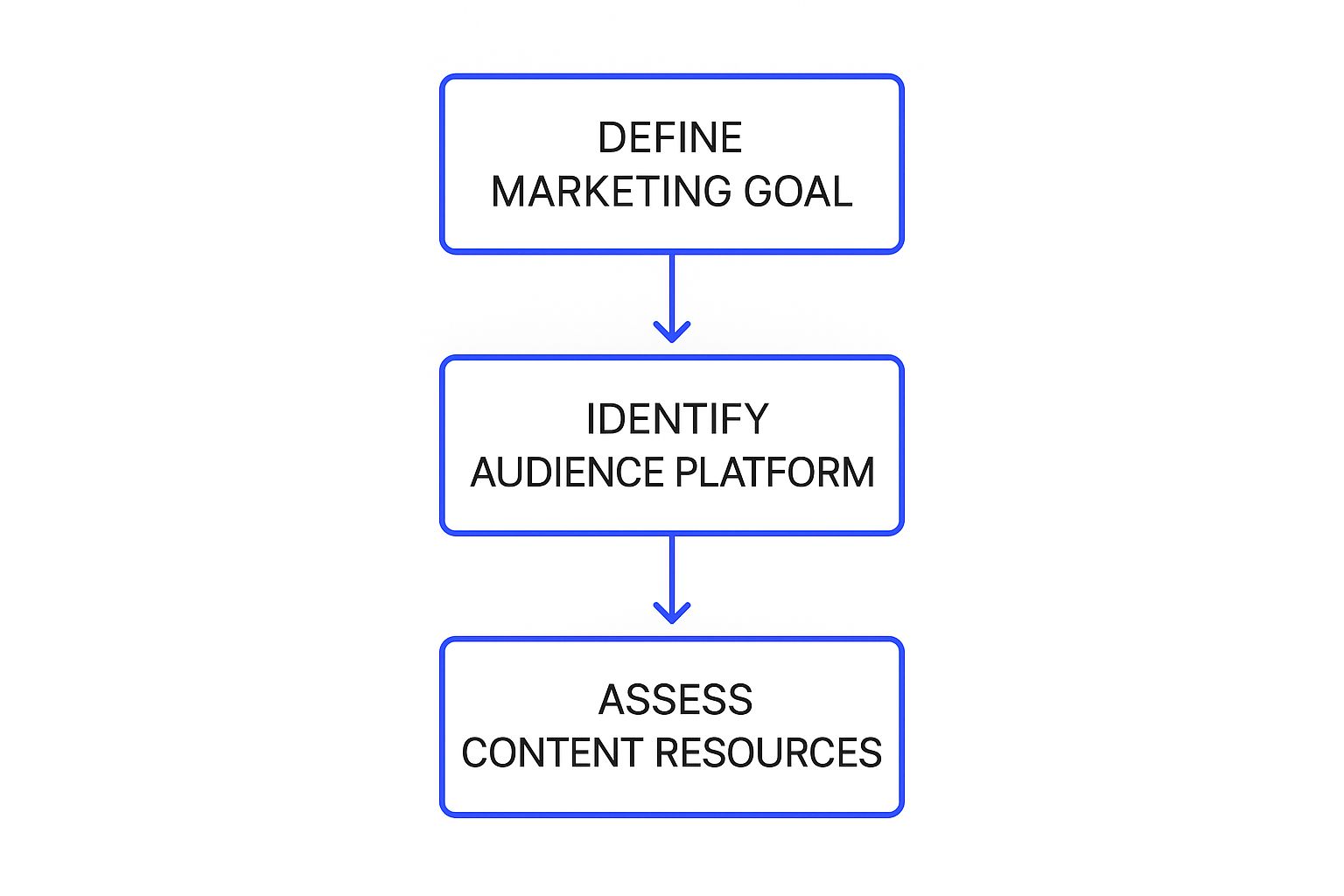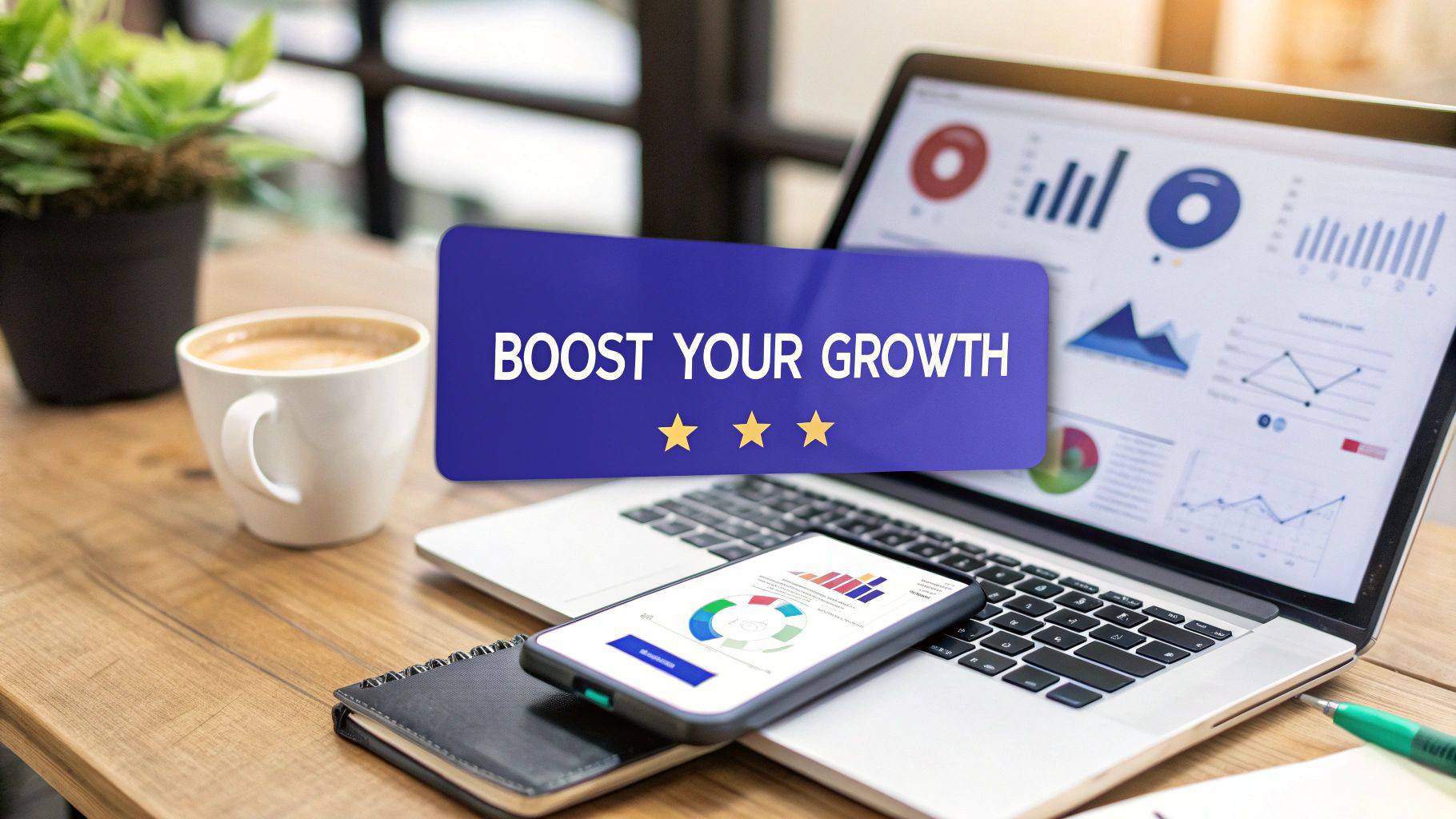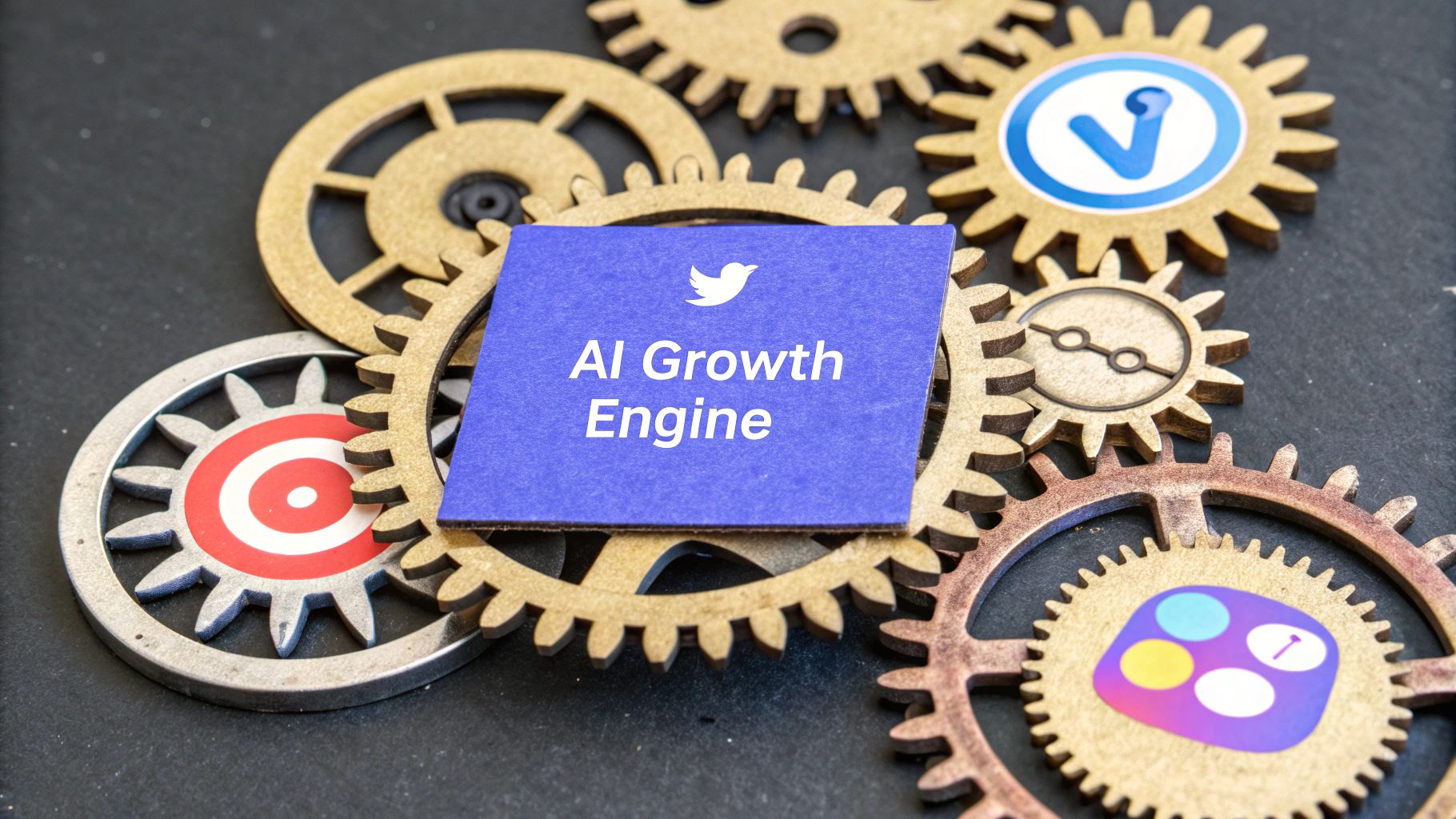When it comes to social media marketing for your small business, the real work happens before you even think about creating a post. It all starts with a targeted strategy—defining what you want to achieve, getting crystal clear on who you're talking to, and picking the right platforms where those people actually hang out.
This foundational work is what separates the businesses that get real results from those that just make noise. Every single post should have a purpose.
Building Your Social Media Foundation
Just jumping onto social media without a plan is a classic mistake. It's like setting out on a road trip with no map—you'll burn a lot of gas and time, but you probably won't get where you intended to go. For a small business, where every minute and dollar is precious, a solid strategic foundation isn't just nice to have; it's non-negotiable.
Forget chasing viral trends for a moment. This first phase is all about making smart, deliberate choices that tie directly back to what your business needs to accomplish.
Let's be real: social media marketing for small business isn't an optional extra anymore. It's standard practice. In fact, it's projected that by 2025, a staggering 96% of small businesses will be using social media in their marketing. They’re doing it to connect directly with customers and hold their own against the big players. This is your chance to compete.
So, where do you begin? It all starts by answering one simple question: "What am I actually trying to achieve here?"
Define Your Primary Business Goals
You can't hit a target you can't see. Vague goals like "get more followers" are a waste of time because they aren't tied to a business outcome. You need specific, measurable objectives. Think about it: what action do you want someone to take after they see your content?
- Increase online sales: Are you an e-commerce shop? Your goal is likely driving traffic to product pages and getting more people to click "buy now."
- Generate qualified leads: If you're a service-based business, maybe you need to book more consultations or get more quote requests filled out on your website.
- Build a community: Perhaps your focus is on creating a loyal tribe of brand fans who not only engage with you but rave about you to their friends.
- Drive foot traffic: For a local brick-and-mortar store, the goal might be as simple as getting people through the door for a weekend sale or special event.
Setting a clear, primary goal gives you a powerful filter. From now on, every content idea, every platform choice, and every ad dollar spent can be measured against it. If it doesn't support that goal, you can confidently say "no" and focus on what will actually move the needle.
Understand Your Ideal Customer
You can't connect with people you don't understand. This is where creating a detailed customer persona—a fictional profile of your ideal client—becomes so important. And I mean detailed. Go way beyond basic demographics like age and location.
What does their day-to-day life look like? What are their biggest headaches or pain points (the ones your product or service solves)? What kind of content do they actually enjoy consuming online? A 25-year-old tech startup employee has wildly different online habits than a 45-year-old parent juggling a household. Your content has to speak their language and fit into their world.
This visual guide is a great way to see how your goal informs who you should be targeting.

As you can see, that marketing goal is the starting point that dictates every single choice you make from here on out.
Pick the Right Platforms
Don't feel pressured to be on every single platform. That's a surefire way to burn out. Instead, go where your ideal customers are already spending their time.
I've put together a quick framework to help you think through this. Use it to match the platform's strengths with your specific business goals.
Platform Selection Framework for Small Businesses
| Platform | Primary Audience | Best For (Content Type) | Business Goal Alignment |
|---|---|---|---|
| Gen X & Millennials | Community building, ads, news/updates, videos | Brand Awareness, Lead Gen, Community | |
| Millennials & Gen Z | High-quality visuals, short videos (Reels), Stories | E-commerce, Brand Building, Influencer Marketing | |
| TikTok | Gen Z & Younger Millennials | Short-form, entertaining, trend-based video | Brand Awareness, Viral Marketing, User-Generated Content |
| Professionals, B2B | Industry insights, company news, long-form articles | B2B Lead Gen, Professional Networking, Recruiting | |
| Predominantly Female, all ages | Visual discovery, tutorials, product showcases | Driving website traffic, E-commerce, Inspiration | |
| X (Twitter) | News junkies, tech, media | Real-time updates, customer service, short text | Customer Service, PR, Real-time Engagement |
This table isn't about giving you a definitive answer, but rather a strategic lens. If you sell visually appealing handmade jewelry, Instagram and Pinterest are no-brainers. If you're a B2B consultant, LinkedIn is your home turf. Match the platform to the plan.
Analyze Your Competitors to Find Gaps
Finally, do a little snooping. Check out what your competitors are doing on social media—not so you can copy them, but so you can learn from them.
See what’s getting them good engagement, but more importantly, look for what isn't working. Is their feed just a boring lineup of sterile product shots with two likes per post? That's your opening. You can come in with authentic, behind-the-scenes content that builds a real human connection. Find the gaps in their strategy and fill them with something better.
For a deeper dive into the practical steps, there's a great guide on getting social media to work for your business. Getting this foundation right ensures your efforts are strategic and impactful from day one.
Choosing the Right Platforms to Build Your Presence

Alright, you've nailed down your goals and have a solid picture of your ideal customer. What's next? Figuring out where on earth to find them.
A classic rookie mistake is trying to be on every single platform at once. It’s a surefire recipe for burnout and weak, diluted content. When you're just starting with social media marketing for small business, the smarter play is to pick one or two platforms and absolutely dominate them before even thinking about expanding.
This is where those customer personas you built come back into play. You have to meet your audience where they already are. A B2B software company trying to go viral on TikTok will probably have a tough time, but a local donut shop? They could build a massive following there.
Matching Your Business to the Platform
Every social network has its own vibe, its own language, and its own audience. And with over 55% of consumers saying they learn about new brands on social media, you need to speak the right language on the right platform.
Let's break down where your business might feel most at home.
Facebook: With over 3 billion monthly active users, Facebook is still the versatile giant in the room. It’s fantastic for building real communities (think Facebook Groups) and running laser-focused ad campaigns. If your audience includes Gen X and Millennials, and you want a central hub for your business, this is a solid bet.
Instagram: Welcome to the kingdom of all things visual. If you sell a product or service that looks amazing on camera—we're talking fashion, food, travel, or interior design—then you absolutely have to be on Instagram. It’s all about Reels, Stories, and stunning photos, making it a powerhouse for brand building and e-commerce.
The trick isn't just posting a pretty picture; it's about telling a visual story. Use carousels to walk people through a process, Reels to share a game-changing tip, and Stories for those raw, behind-the-scenes moments that build trust.
Where Niche Audiences Gather
While Facebook and Instagram get most of the attention, don't sleep on the platforms that cater to more specific crowds. Sometimes, a smaller, hyper-engaged audience is worth far more than a massive, indifferent one.
LinkedIn: If you're a B2B business, a consultant, or any kind of professional service provider, LinkedIn is non-negotiable. It's the one place where users are already in a business mindset. Content that shares industry insights, career advice, and company updates does incredibly well here.
TikTok: Forget the idea that it's just for dancing teens. TikTok's algorithm is a beast, offering small businesses insane organic reach. If your brand has a bit of personality and you can create short, entertaining, or educational videos, this platform is a goldmine for reaching younger Millennials and Gen Z.
Pinterest: Is your business in a visual field like home decor, recipes, wedding planning, or DIY crafts? Pinterest can drive a staggering amount of traffic to your website. Users are on there to plan and find inspiration, which means they are in the perfect mindset to discover and buy new products.
If you're still weighing your options, our guide on choosing the right social media platform dives even deeper to help you lock in the perfect fit for your business.
Optimizing Your Profile for a Strong First Impression
Once you’ve picked your platform(s), it’s time to set up shop. Think of your profile as your digital storefront—you only have a few seconds to make a great first impression. Don't waste it with a blurry photo or a confusing bio.
A powerful profile boils down to a few key things:
- A Clear Profile Picture: Use a high-res version of your logo or a professional headshot. It needs to be recognizable even when it's just a tiny circle.
- A Compelling Bio: Get straight to the point. Tell people what you do and who you help. Sprinkle in some keywords your ideal customer would be searching for.
- A Link to Your Website: This is your main call to action! If you have multiple important links, a tool like Linktree can be a lifesaver for directing people to your blog, shop, or contact page.
Your social media profile is often the very first handshake a potential customer has with your brand. Make it count.
Creating a Content Strategy That Actually Connects
You’ve laid the groundwork and picked your platforms. Now for the fun part—and honestly, the most important part: the actual content.
This is the engine that drives your entire social media machine. You can have the best strategy in the world, but without great content, it’s just not going to work. Your goal isn't just to fill a feed; it's to create stuff that genuinely stops the scroll, sparks a real conversation, and makes people feel something about your brand.
Throwing random posts out there just leads to a feed that feels scattered and, frankly, a bit desperate. A real content strategy makes your audience see you as a go-to resource, not just another business trying to make a sale.
Building Your Content Pillars
The secret to a feed that feels both interesting and consistent? Content pillars.
Think of these as 3-5 core themes you’ll talk about over and over again. Instead of waking up and wondering, "What on earth do I post today?" you'll have a reliable framework to draw from. It keeps your content varied but still focused on what your audience cares about.
For most small businesses I've worked with, a mix of these four pillars is a winning formula:
Educational Content: This is all about solving problems for your audience. Share your expertise! Think tips, how-to guides, or little-known industry facts that make their lives easier. If you run a local bakery, this could be a quick video on "Three Secrets to the Perfect Sourdough Starter."
Behind-the-Scenes Content: People want to connect with other people, not faceless logos. Show them the human side of your business. Introduce your team, share a peek at how your product is made, or celebrate a business milestone. This stuff builds trust and authenticity like nothing else.
Community-Focused Content: Turn the spotlight on your audience. Share photos from customers using your product (this is called user-generated content, or UGC), run a poll asking for their opinion, or feature a loyal customer's story. It makes people feel like they're part of something special and turns followers into your biggest fans.
Promotional Content: Of course, you still need to sell! But here’s the trick: when your salesy posts are sprinkled between all that other valuable content, they feel natural and welcome. Announce new products, share a special offer, or post a glowing customer review. The key is to make it helpful, not just hype.
The best social media feeds I see follow a simple rule: give, give, give, then ask. When you consistently deliver value with educational, behind-the-scenes, and community content, you earn the right to promote your business without annoying your audience.
Crafting a Recognizable Brand Voice and Style
Consistency is what makes a brand stick in someone's memory. You need a distinct brand voice and a clear visual identity that comes through in every single post, story, and even your replies to comments.
Is your brand voice witty and a little bit cheeky? Or is it more professional and reassuring? Figure it out, write it down, and stick to it. This is how you build familiarity and trust.
Over time, people should be able to recognize one of your posts in their feed before they even see your name. The same goes for your visuals. Pick a consistent color palette, a couple of go-to fonts, and a specific photo editing style. You don't need to be a graphic designer—free tools like Canva have fantastic templates that make it simple to create a polished, uniform look.
If you want to go deeper on this, we've put together a complete guide on how to build a social media content strategy that walks you through this entire process.
Planning and Scheduling for Consistency
Great ideas are worthless if they just stay in your head. For a busy small business owner, a content calendar is your absolute best friend. It turns your strategy from a bunch of notes into a real, actionable plan.
It doesn't have to be fancy. A simple spreadsheet or a dedicated scheduling tool is all you need.
Start by mapping out your posts for the week or month, making sure to assign each idea to one of your content pillars. This simple workflow is a game-changer for a few reasons:
- It Forces Consistency: No more last-minute panic when you realize you haven't posted in three days. Staying consistent is how you stay top-of-mind.
- It Saves a Ton of Time: Batching your work—writing all your captions for the week at once, designing your graphics in one session—is way more efficient than trying to do it all from scratch every single day.
- It Keeps You Balanced: A calendar gives you a bird's-eye view of your feed. You can easily spot if you're posting too much promotional stuff or forgetting about one of your key pillars.
Social media management tools can put this whole process on autopilot. You can schedule your posts to go live at the perfect times—when your audience is most active—which means more visibility without you having to be glued to your phone. This is how you turn social media from a daily chore into a predictable and powerful part of your marketing.
Using Paid Ads to Amplify Your Message

Relying just on organic reach can sometimes feel like shouting into the wind. This is where a smart, targeted paid advertising strategy can completely change the game, putting your message directly in front of the people most likely to become your next customers.
Paid social ads level the playing field. They let you compete with bigger brands without needing a six-figure marketing budget. You’d be surprised what even a few dollars a day can do when you spend it wisely.
Setting a Realistic Ad Budget
The first question I always get from small business owners is, "How much should I actually spend?" There's no magic number, but the good news is you don't need thousands to get started. The key is to begin small, see what works, and then scale.
A great starting point is a daily budget of $10-$20 for your first campaign. This is enough to gather meaningful data without a huge financial risk. Think of it as an investment in learning—you’re paying to discover which messages, visuals, and audiences click with your brand.
Once you have a campaign that’s actually making you money by driving sales or leads, you can confidently reinvest some of that profit back into your ad budget. This is how you create a sustainable cycle of growth.
Harnessing Powerful Ad Targeting
The real magic of social media marketing for small business advertising lies in its incredible targeting. You can get so specific about who sees your ads, which means you stop wasting money on people who will never buy from you.
Platforms like Facebook and Instagram give you some seriously powerful options:
- Demographics: Target by age, gender, location, language, and even job title. A local coffee shop, for instance, can target people within a five-mile radius of their front door.
- Interests: Reach people who've shown interest in topics related to your business, like "organic skincare," "home brewing," or "vintage fashion."
- Behaviors: Zero in on people based on their online activities, like those who have recently made an online purchase or frequently engage with pages similar to yours.
- Custom Audiences: This is a big one. You can upload your email list to show ads to your existing customers or create a "lookalike" audience to find new people who are eerily similar to your best clients.
The goal is to shift from broad, scattergun advertising to precision marketing. By layering these targeting options, you can build an audience profile so specific that it feels like your ad was made just for them. That's the kind of relevance that drives clicks and conversions.
Choosing the Right Ad Objective
Before you hit "launch," the platform will ask you to choose an objective. This is a crucial step. It tells the algorithm exactly what you want to achieve, and it will optimize your ad delivery to get you that result.
For a small business, your objectives will likely fall into one of these buckets:
- Brand Awareness: Just want to get your name out there? This objective shows your ad to as many people as possible within your target group to introduce them to your business.
- Traffic: The goal here is simple: drive people to a specific place, like your website's homepage, a new blog post, or a product landing page.
- Lead Generation: This is perfect for service-based businesses. You can collect contact information (like email addresses) with a pre-filled form right on the platform, making it incredibly easy for potential customers to connect.
- Sales/Conversions: For e-commerce, this is your bread and butter. It encourages people to take a specific action on your website, like making a purchase. You'll need a tracking pixel installed for this to work.
Choosing the right objective has a direct impact on your results. A local plumber running a special offer would choose "Lead Generation" to get phone numbers. An e-commerce store launching a new product line would focus on "Sales."
The world of paid social is only getting bigger, with total ad spending projected to hit $276.7 billion. A huge driver of this is mobile—by 2029, it's estimated that a staggering 83% of all social ad spending will come from mobile devices. This just goes to show how critical it is to create ads that are visually compelling on a small screen. You can dig into more of these trends by exploring social media advertising statistics.
Building Trust by Collaborating with Influencers
Believe it or not, influencer marketing isn't just a game for huge brands with bottomless budgets. For a small business, it's one of the most direct ways to build credibility and tap into new, hyper-engaged audiences. This is all about finding trusted voices to share your story in a way that feels like a real recommendation, not a sales pitch.
The secret? Think smaller. You don't need celebrities with millions of followers. Your most powerful allies are often micro-influencers—creators with tight-knit communities who genuinely trust their recommendations. An endorsement from them lands like a tip from a good friend, and that's marketing gold.
This approach works because people are tired of traditional ads. The numbers don't lie: influencer marketing is pulling in an average return on investment (ROI) of $5.78 for every dollar spent. That's almost double what you get from many standard digital ads. Trust is the engine here, with 61% of consumers saying they rely on influencer endorsements more than they do on brand advertising. For more stats on this, check out these insights on influencer marketing from Sprinklr.
Finding the Right Influencer Partners
The success of your entire campaign rests on finding the right fit. It's not about chasing follower counts; it's about finding a creator whose audience and values are a perfect match for your brand. A bad fit feels forced and can hurt both your credibility and theirs.
Start by digging around for creators who are already passionate about your niche. You can unearth some real gems by:
- Searching relevant hashtags: Dive into hashtags in your space (think #HandmadeJewelry or #LocalCoffeeShop) and see who's making great content.
- Checking your own followers: You might be sitting on a goldmine. Some of your most engaged fans could have influential accounts of their own.
- Analyzing your competitors: See who your competitors are teaming up with. This is a great way to understand what kind of influencers connect with your ideal customer.
Once you have a shortlist, do your homework. Look for real, consistent engagement—comments and conversations, not just likes—and an authentic vibe with their followers.
Structuring a Fair Collaboration
After you've pinpointed a great potential partner, it's time to reach out with a professional, clear proposal. Skip the generic DMs. Personalize your message, tell them why you think they're a great fit, and mention something specific you admire about their content.
When it's time to talk compensation, remember there's no single right answer. It all depends on the influencer's audience size and what your budget can handle.
Key Takeaway: The best influencer partnerships are built on mutual respect and crystal-clear expectations. Get everything in writing upfront—the number of posts and stories, key talking points, and how you can use the content later.
Here are a few common ways small businesses can structure a deal:
- Gifting: For creators just starting out, offering free products for an honest review can be a perfect entry point.
- Affiliate Commissions: Give the influencer a unique discount code or link. They'll earn a cut of every sale they drive, making it a true win-win.
- Flat Fee: For more established micro-influencers, a set payment per post or for the whole campaign is pretty standard. This gives them predictable income and guarantees you get the content you paid for.
At the end of the day, a powerful influencer collaboration is about building a real relationship. Treat your partners well, give them some creative freedom, and aim for long-term partnerships over quick, one-off posts. That's how you build the kind of authentic word-of-mouth that truly moves the needle.
Measuring Performance and Optimizing for Growth

Let's get one thing straight: effective social media marketing isn't about guesswork. It’s all about the data. If you really want to know if your hard work is paying off, you need to measure what matters, learn from the results, and constantly tweak your approach.
This isn’t just about collecting numbers. It's about creating a powerful feedback loop that turns your social media presence into a reliable engine for business growth.
The first step? Stop obsessing over vanity metrics like follower counts. Sure, a big audience looks good on paper, but it means very little if those followers aren't actually engaging with your content or, better yet, becoming customers. We need to focus on the metrics that tie directly back to your business goals.
Key Metrics That Actually Matter
To get a real, unfiltered picture of your performance, you need to dive into the native analytics tools each platform offers. Think Instagram Insights or Meta Business Suite. These dashboards are goldmines of valuable information.
To start, get comfortable tracking these essential data points:
- Engagement Rate: This is the percentage of your audience that interacts with your posts—we’re talking likes, comments, shares, and saves. A high engagement rate is a clear sign that your content is hitting the mark with your community.
- Click-Through Rate (CTR): This one’s simple but critical. It measures how many people actually clicked the link in your post or bio. It’s the metric that tells you if your social media is successfully sending traffic to your website.
- Conversions: For most small businesses, this is the end goal. This metric tracks how many users took a specific, desired action after clicking your link, like making a purchase, signing up for your newsletter, or filling out a contact form.
By focusing on metrics like engagement and conversions, you shift from simply being on social media to strategically using social media. It's the difference between being busy and being productive.
Using Data to Refine Your Strategy
Your analytics are so much more than just numbers on a screen; they are direct, honest feedback from your audience. It’s your job to use these insights to make smarter decisions about what you create and when you post it.
For a really deep dive on this, check out our guide to social media analytics and reporting. It’s packed with insights on turning raw data into an actionable plan.
https://postsyncer.com/blog/social-media-analytics-and-reporting
Take a look at your best-performing posts from the last month. What do they all have in common? Maybe they were all short-form videos, or perhaps they all featured a customer testimonial. This is your audience telling you exactly what they want to see more of.
And please, don't be afraid to experiment. A simple A/B test, like running two ads with different headlines or images, can give you crystal-clear data on what works best. Even something as small as changing the call-to-action in your bio and tracking clicks for a week can reveal powerful insights. This ongoing cycle of measuring, learning, and optimizing is what ensures your strategy stays sharp and continues to deliver real results.
Your Top Social Media Questions, Answered
Jumping into social media for your small business always brings up a few key questions. Let's tackle some of the most common ones I hear from entrepreneurs so you can move forward with a clear, confident plan.
How Much Should We Really Be Spending on Social Media?
This is the million-dollar question, isn't it? While there’s no magic number, a solid rule of thumb is to dedicate 5-15% of your total marketing budget to your social media efforts. That bucket should cover both your ad spend and any tools you need to get the job done.
If you're just dipping your toes into paid ads, don't go all in at once. Start small. A test budget of $10-$20 a day is more than enough to see what’s working. The whole point is to track your return. If a campaign is bringing in more than it costs, you've found a winner and can feel good about putting more money behind it.
What's the "Right" Amount to Post Each Week?
Forget the old advice about posting constantly. These days, quality and consistency trump sheer volume every single time. Honestly, posting three genuinely valuable, interesting pieces of content a week is worlds better than pushing out seven forgettable posts that no one engages with.
Here’s a good rhythm to start with:
- Instagram & Facebook: 3-5 times per week usually hits the sweet spot.
- LinkedIn: For a professional audience, 2-3 high-impact posts a week can work wonders.
- TikTok & X (Twitter): These platforms can handle a higher frequency, but only if you have a genuine stream of relevant things to share.
The real secret? Find a schedule you know you can stick to. From there, keep a close eye on your analytics to see when your audience is actually online and listening.
What Are the Best Free Tools for a Small Business on a Budget?
You can get an incredible amount done without opening your wallet. Starting with free tools is the smartest way to manage your social media marketing for a small business when every dollar counts.
You don't need a big software budget to look professional. Canva's free version is a powerhouse for creating graphics. For scheduling, Meta Business Suite lets you plan out your Facebook and Instagram content for free. And don't forget, every platform's built-in analytics—like Instagram Insights—gives you all the essential data you need to start making smarter decisions.
Ready to manage your social media marketing like a pro? PostSyncer centralizes your scheduling, analytics, and content creation with powerful AI tools. Streamline your workflow and get real results. Start your free 7-day trial of PostSyncer today.















